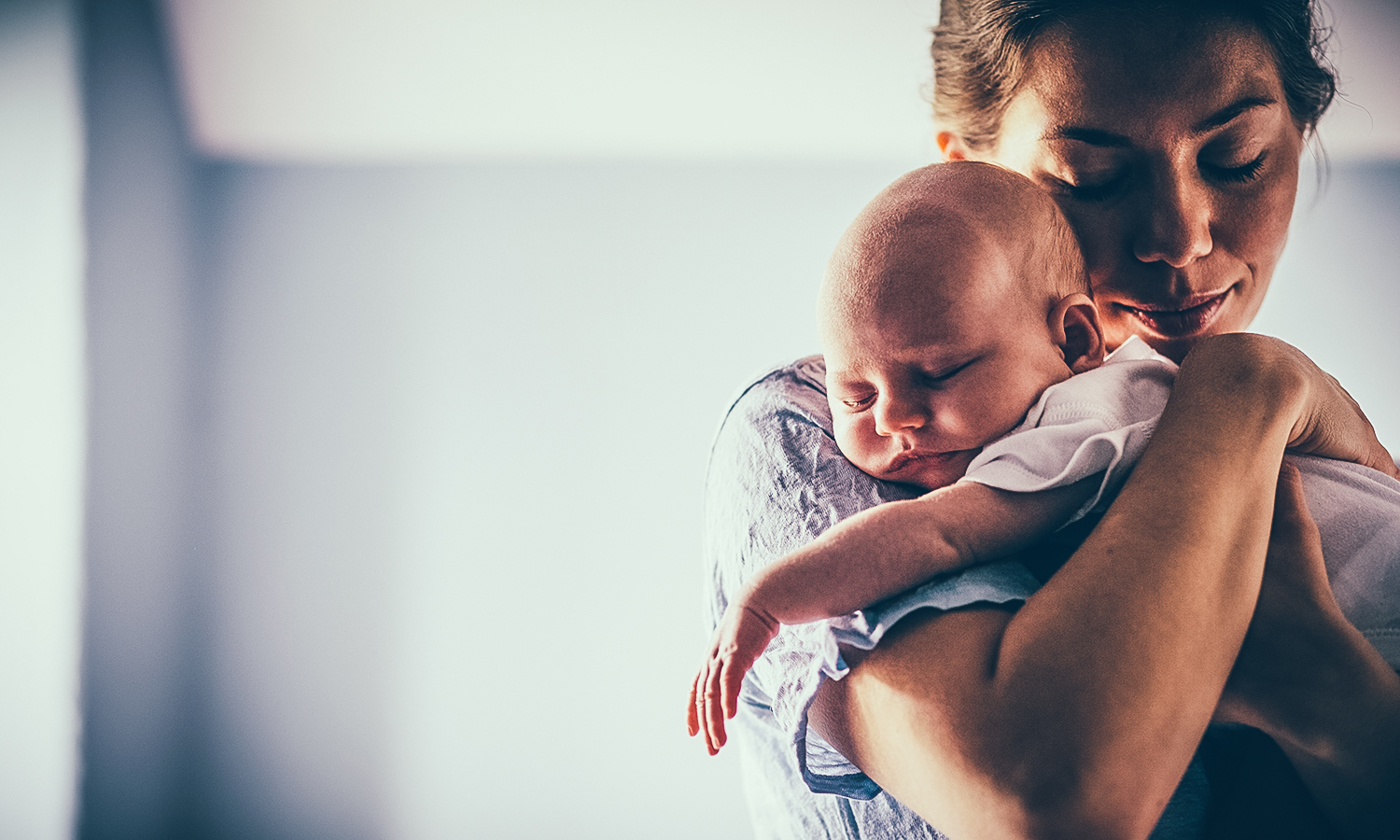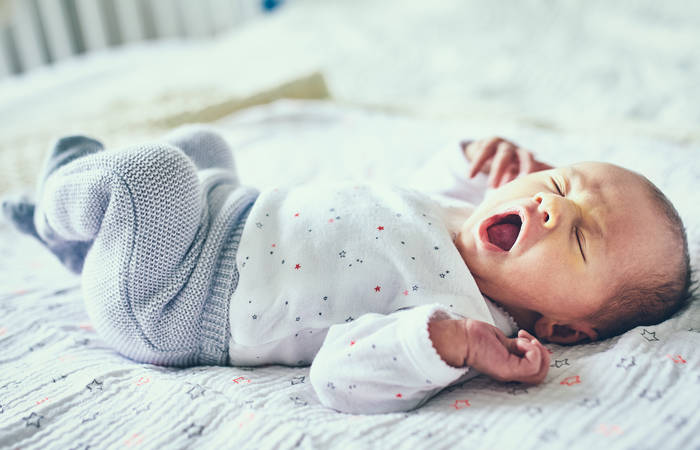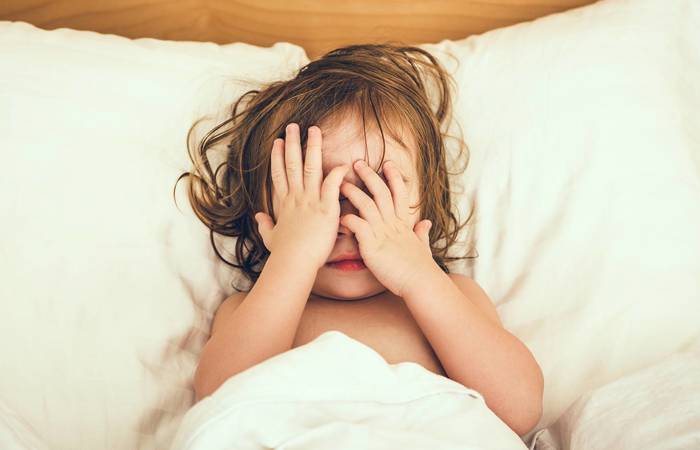Like what you see?
Sign up to receive more free parenting advice.
Thank you for subscribing to our newsletter!
Child Development

Credit: iStock.com/SolStock
Registered nurse, midwife and author of The Tresillian Sleep Book Fran Chavasse says too many people mistakenly believe that children can learn to sleep at any age. In this three-part series, Fran offers her advice on normal baby sleep development, sleep cycles and cues.
Bringing home your new baby is very exciting but it’s also kind of nerve-wracking, especially if she’s your first.
One of the biggest concerns for many parents is whether your baby is going to sleep during the night. It can cause some apprehension, especially if you’re a single parent, or managing most of your baby’s care both day and night; or you have to get back to study or paid work early on in your baby’s life.
There’s no doubt it’s important to get as much sleep as you can so you can focus and function during the day.
Many parents talk about feeling sleep-deprived, especially in the first few months and the reality is you won’t be getting the amount or quality of sleep that you had before your baby arrived.
Every new parent experiences some degree of sleep exhaustion depending on how much sleep they are used to getting. So it is sad that one of the losses of becoming a parent happens to be your usual amount and quality of sleep!
From your perspective waking several times a night to resettle and feed your baby can be stressful but to be fair-minded your baby really can’t help waking you up at night.
Why babies wake
So seeing she can’t help waking you up, it’s good to understand her reasons for doing so.
Your baby wakes you several times a night because it is developmentally normal during the first year. Your baby’s sleep has a developmental course just the same as she develops the ability to walk and talk.
Just like walking and talking, your baby’s sleep develops in a step-like way, so being able to sleep through the night without waking takes time and is pretty much the last step to develop and mature over the first year of life.
Therefore, your baby’s sleep development is controlled internally by her brain and body chemicals and is quite a complex process.
Sleep is also affected externally by how you help organise her sleep environment. So you could say you have a sleep relationship.
You help her sleep development much the same way you help her learn to speak and give her opportunities to roll, sit up, crawl and walk.
The development of normal sleep
So first off, let’s talk about the development of normal sleep. When you first bring your baby home she doesn’t have a 24-hour day-night pattern like you.
She will feed and sleep at any time around the 24-hour clock until she’s about four weeks old. Then at about four weeks she’ll begin to sleep more at night and be wakeful during the day.
This 24-hour clock is her circadian rhythm which involves physical, emotional and social tasks which are vital for healthy sleep. It’s very important to help your baby establish her day-night rhythm because this is the first phase of sleep development.
So, how do you do it? Firstly it’s really important that your baby has good exposure to natural bright daylight especially during the morning and early afternoon. That means making sure your home has plenty of natural light, with curtains open during the day.
Going for a walk in the pram especially in the afternoon is great for daylight exposure; although it’s important to make sure your baby is not exposed to the sun.
Of course summer is much easier to get more daylight than winter so an afternoon walk in winter is a good option if it isn’t too cold. Daytime naps don’t have to be in a totally blacked out room; as long as the curtains or blinds are closed and the room dimmed.
Next, your baby definitely needs at least a 9-10 hour period of natural darkness each night. This means putting her to bed in a darkened room away from the rest of the household where there are bright lights and noise.
In fact all children require quiet and darkness to sleep well. A really important aspect of maintaining a period of darkness is to avoid keeping your baby too long under artificial lights.
Artificial lighting extends her day through extra socialising and even extra feeds when she’s not really hungry. So artificial lights in the evenings are very stimulating and can set back the development of your baby’s natural circadian rhythms during the first four weeks.
The type of lighting that messes with your baby’s and later on your toddler and pre-schoolers circadian rhythms is short-wave blue lights.
This light is found in fluorescent lights, mobile phones, tablets, computers, televisions and gaming consoles which we use everywhere at all times of the day and night. These lights are very stimulating and will delay the onset of sleep, keeping your baby (as well as you) awake much longer than you need to be.
The answer to this is keep your baby’s sleep space dimly lit with a red or yellow, these lights won’t interrupt you or your baby’s circadian rhythms.
Keep social interactions to a minimum at night, however, it’s important to still make eye contact with your baby; that’s how you and she communicate all your emotional information.
Eye contact, gentle, rhythmic touch and a soft, soothing voice is what your baby needs for reassurance so she can settle and sleep at night.
Stay up to date with the latest news and articles from First Five Years
Thank you for subscribing to our newsletter!
Bedtime routines
A good way to help your baby establish healthy sleep is to start a predictable and flexible bedtime routine right from the beginning. During the daytime hours this can be as quick as a nappy change, swaddle/wrap, a loving kiss and into bed with a gentle pat.
The night time routine needs to signal that a longer sleep with prolonged darkness is about to happen, so this bedtime routine might include bath time, soothing songs, cuddles, stories and the final swaddle/wrap, kiss and into bed.
Your baby’s night time routine only needs to be about 10-15 minutes when she is very young as well as how tired she is. The length of the bed time routine gradually increases to about 40 minutes from 12-18 months of age.
Day time napping
So from four weeks you have established your baby’s night time sleeps what about the day?
The day is for social times and feeding is the most social time of all. This is the time when you make eye contact and talk about your day, just like you do with your friends and family when you have a meal with them.
Feeding is your social time together. You also have short play-times with your baby, with short daytime naps in between.
So day time is clearly the designated wakeful time. However, your baby’s brain regulates her sleep and her brain will tell her when it’s time for sleep.
Most newborn babies sleep on average about 14 hours a day, some babies may sleep as much as 16 hours a day but each baby is an individual and no one can predict how many hours your baby will need.
By 12 months your baby will probably sleep about 12 to 13 hours a day including short daytime naps.
Understanding sleep cues
So the next interesting thing is that you and your baby’s sleep works in the same way. Your need for sleep builds up over the day and then finally you have to go to sleep and so you do until you don’t need any more and wake up; except for when you have a baby.
Your baby’s need for sleep builds up in the brain more quickly – that’s why she needs more sleep; but she still can’t sleep until she’s ready, in other words you can’t teach her brain to sleep.
Your baby needs to be ready and you can tell she’s ready by when she shows you she’s drowsy and sleepy along with some sleep cues.
Sleep cues look like these:
- Heavy eye lids
- Yawning
- Being still
- Being quiet
- Not alert
- May be fussy
- Restless
- Glazed or dull eyes
- Sucking on hands
- Sudden startles.
It’s important to put together:
- Several sleep cues together
- Look to see if your baby seems drowsy
- Think about how long it has been since your baby’s last sleep.
You are more likely to be successful in getting your baby to sleep when you put those three features of sleep together.
Baby sleep cycles
You’ve probably heard about the next part of normal sleep and that’s the development of your baby’s sleep cycles.
Your baby has sleep cycles of about 50-60 minutes long and they consist of an episode of active sleep to quiet sleep to active sleep.
Quiet sleep and active sleep have their own particular physical and behavioural patterns.
Now it’s quite easy to see when your baby is in quiet sleep because she’s still, doesn’t have much body activity, breathes quietly and evenly and her face is totally at rest.
All those pictures you see of babies looking like little angels nicely fast asleep are probably babies in quiet sleep.
However, active sleep is a little more confusing and you could think your baby is starting to wake up. When your baby is in active sleep she has quite a lot of body activity and is much more responsive to noise. Her eyes will flutter under her eyelids and her face is more expressive and she may even smile. This is normal for active sleep but she’s not awake – she’s just dreaming.
Active sleep is very important for your baby’s brain development, especially in the very early months when she isn’t awake much so she definitely needs her active sleep. As she becomes more wakeful and sociable she has less active sleep.
Now there’s something else occurs after a full sleep cycle which may confuse you and eventually lead to some sleep difficulties, especially in the first six months as her sleep is maturing.
As she moves between a full sleep cycle to the next cycle, she has a transitional or drowsy stage where she opens and closes her eyes, breathes irregularly and she could even make fussy little noises, cry or call out. All of these behaviours could easily lead you to see if she’s ready for a feed, nappy change or cuddle.
This is when your baby needs to develop the ability to settle herself back to sleep, but it takes time. Your newborn baby and right up to three months of age isn’t very good at self-soothing and settling.
Her sleep cycles are very immature so she will definitely require help to resettle during both the day and night. She may not want a feed during each of these resettles.
The reason for this waking is because she still hasn’t got the ability to self-soothe back to sleep. In fact this is the last part of sleep development to occur.
When she does stir and can’t self-soothe, this is the time to try a gentle rhythmic pat, rewrap or a slow rocking motion rather than feeding if it’s not a feed time.
After three months your baby will begin to sleep longer during the first part of the night, she may sleep anything from 3-5 hours at one stretch, but that depends on your baby’s biological make-up, how much sleep she needs, her personality and family environment.
She’s very like you; when you think about it, your sleep relies on all those factors as well. at six months she will have the ability to sleep 5-7 hours at one stretch at the beginning of the night and wake two to three times in the early hours of the morning and by 12 months have two six-hour sleeps with one to three awakenings each night where she may need help to resettle.
This is normal sleep for the first 12 months. Some babies have a much better ability to self-soothe themselves back to sleep and other babies don’t and their development takes time and they need a bit more help.
Sleep difficulties occur when your baby goes to bed and can’t go to sleep on her own and during the period where your baby stirs between the sleep cycles and tries to self-soothe back to sleep.
You and your baby’s sleep is a relationship so when either of these two sleep disruptions occur you both need to adjust what’s happening.








